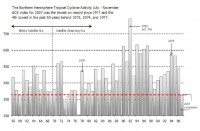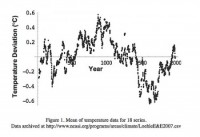
|
Dec 01, 2007
2007 Blown Off Track: Northern Hemisphere Historic Cyclone Inactivity
By Ryan Maue, FSU as a post on Climate Audit
As reported at Climate Audit at the end of October, the North Atlantic was not the only ocean seeing quiet tropical cyclone activity. When using the ACE cyclone energy scale, the Northern Hemisphere as a whole is historically inactive. How inactive? One has to go back to 1977 to find lower levels. Even more astounding, 2007 will be the 4th slowest year in the past half-century (since 1958).
The 2007 Atlantic Hurricane season did not meet the hyperactive expectations of the storm pontificators. This is good news, just like it was last year. With the breathless media coverage prior to the 2006 and 2007 seasons predicting catastrophic swarms of hurricanes potentially enhanced by global warming a la Katrina, there is currently plenty of twisting in the wind to explain away the hyperbolic projections. The predominant refrain mentions something about “being lucky” and having “escaped” the storms, and “just wait for next year”.
When combined, the 2006 and 2007 Atlantic Hurricane Seasons are the least active since 1993 and 1994. When compared with the active period of 1995-2005 average, 2006 and 2007 hurricane energy was less than half of that previous 10 year average. The most recent active period of Atlantic hurricane activity began in 1995, but has been decidedly less active during the previous two seasons. When combined, the Eastern Pacific and the North Atlantic, which typically play opposite tunes when it comes to yearly activity (b/c of El Nino), brushed climatology aside and together managed the lowest output since 1977. In fact, the average lifespan of the 2007 Atlantic storms was the shortest since 1977 at just over two days. This means that the storms were weak and short-lived, with a few obvious exceptions.

See full size image and more on Climate Audit and on TC07 COAPS, Ryan Maue’s Homepage.
Nov 30, 2007
Decisions to Name Storms Draw Concern
By Eric Berger, Houston Chronicle
With another hurricane season set to end this Friday, a controversy is brewing over decisions of the National Hurricane Center to designate several borderline systems as tropical storms. Some meteorologists, including former hurricane center director Neil Frank, say as many as six of this year’s 14 named tropical systems might have failed in earlier decades to earn “named storm” status. “They seem to be naming storms a lot more than they used to,” said Frank, who directed the hurricane center from 1974 to 1987 and is now chief meteorologist for KHOU-TV. “This year, I would put at least four storms in a very questionable category, and maybe even six.”
Most of the storms in question briefly had tropical storm-force winds of at least 39 mph. But their central pressure — another measure of intensity — suggested they actually remained depressions or were non-tropical systems. Any inconsistencies in the naming of tropical storms and hurricanes have significance far beyond semantics. The number of a season’s named storms forms the foundation of historical records used to determine trends in hurricane activity. Insurance companies use these trends to set homeowners’ rates. And such information is vital to scientists trying to determine whether global warming has had a measurable impact on hurricane activity. Read more here.
Nov 29, 2007
Global Warming is Not About to Unleash Hell on Us
By Nigel Lawson, former British Cabinet minister
As it is, the temperature projections (the Intergovernmental Panel on Climate Change) does come up with in its fourth and latest report range from a rise in the global average temperature by the year 2100 of 1.8C for its lowest emissions scenario to one of 4C for its highest emissions scenario, with a mean increase of slightly under 3C. The average annual temperature in Helsinki is less than 5C. That in Singapore is in excess of 27C, a difference of more than 22C. If man can cope with that, it is not immediately apparent why he should not be able to adapt to a change of 3C when he is given 100 years in which to do so. The major cause of ill-health, and the deaths it brings, in the developing world is poverty. Faster economic growth means less poverty but - according to the man-made CO2 warming theory, incorporated in the IPCC’s scenarios - a warmer world. Warmer but richer is in fact healthier than colder but poorer.
The more one examines the current global warming orthodoxy, the more it resembles a Da Vinci code of environmentalism. It is a great story and a phenomenal bestseller. It contains a grain of truth and a mountain of nonsense. And that nonsense could be very damaging indeed. We appear to have entered a new age of unreason, which threatens to be as economically harmful as it is profoundly disquieting. Read his excellent lecture here. Read media coverage here.
Nov 29, 2007
2007 Cools, Set to be 6th Warmest Year on Record
By Alister Doyle, Environment Correspondent, Reuters
This year is set to be the sixth warmest since records began 150 years ago, cooler than earlier predicted which means a slight respite for European ski resorts or bears trying to hibernate. “2007 will likely be near equal with 2006, so joint sixth warmest year,” Phil Jones, head of the Climatic Research Unit at Britain’s University of East Anglia, told Reuters.
The unit, which provides global data for the World Meteorological Organization (WMO), had predicted a year ago that 2007 could be the warmest worldwide since reliable records began in the 1860s. It cut the prediction to number 2 in mid-year.
Many of Europe’s Alpine ski resorts—starved of snow a year ago—have opened. In Switzerland 48 resorts, or more than half the total, opened about 10 days ago after good early snows and freezing temperatures. In northern Europe, resorts such as Hafjell have opened weeks before last year, when temperatures were too high even for snow-making machines.
And bears in a Bulgarian conservation park are starting to doze off for winter hibernations, around the normal time, after last year’s mild winter badly disrupted their sleep. “Four of the bears are sleeping already. The weather was a bit warm but last week it became colder and it snowed so they have fallen asleep,” said Raya Stoilova of the “Four Paws” foundation of 24 bears in a conservation park. For more go here. Note: The statement attributed to the IPCC “Eleven of the 12 years from 1995 to 2006 were among the 12 warmest years on record” is clearly not factual. For the US in the last century for example 6 of the 10 warmest were before 1960. There are major issues with the global data bases that make them unreliable for such an assessment.
Nov 27, 2007
The Trees Were Kidding: World Was Warmer Just a Few Centuries Ago
By Andrew Bolt, Herald Sun
The IPCC used it (the ‘hockey stick") in its third assessment report. Al Gore used it in his movie. In fact, no graphic has had such a huge effect as the infamous hockeystick produced by Michael Mann, who used tree ring data to allegedly show that the last century’s warming was unprecedented, and the globe had never in 2000 years been this hot.
Small problem. Mann’s manipulation of the statistics has since been discredited, and the graph dropped out of the IPCC’s fourth report. But the damage has been done. Millions of people now firmly believe the world hasn’t been this hot in recorded history, not even during the Medieval Warm Period. Now a new study says Mann didn’t just get the maths wrong, but could have been using tainted data as well. Ecological modeller Dr Craig Loehle has checked other proxy data, rather than the tree rings he says are unreliable, and comes up with a very different graphic indeed:

Says Loehle: “There are reasons to believe that tree ring data may not properly capture long-term climate changes. In this study, eighteen 2000-year-long series were obtained that were not based on tree ring data. Data in each series were smoothed with a 30-year running mean. All data were then converted to anomalies by subtracting the mean of each series from that series. The overall mean series was then computed by simple averaging. The mean time series shows quite coherent structure. The mean series shows the Medieval Warm Period (MWP) and Little Ice Age (LIA) quite clearly, with the MWP being approximately 0.3°C warmer than 20th century values at these eighteen sites.” To sum up. This warming is not unusual. The planet was warmer less than 1000 years ago. Oh, and see the fall in temperatures since 1998’s high, which so panicked so many people. Read more here.
|
|
|
|




